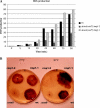Interaction between the oxa1 and rmp1 genes modulates respiratory complex assembly and life span in Podospora anserina
- PMID: 15545650
- PMCID: PMC1449539
- DOI: 10.1534/genetics.104.033837
Interaction between the oxa1 and rmp1 genes modulates respiratory complex assembly and life span in Podospora anserina
Abstract
A causal link between deficiency of the cytochrome respiratory pathway and life span was previously shown in the filamentous fungus Podospora anserina. To gain more insight into the relationship between mitochondrial function and life span, we have constructed a strain carrying a thermosensitive mutation of the gene oxa1. OXA1 is a membrane protein conserved from bacteria to human. The mitochondrial OXA1 protein is involved in the assembly/insertion of several respiratory complexes. We show here that oxa1 is an essential gene in P. anserina. The oxa1(ts) mutant exhibits severe defects in the respiratory complexes I and IV, which are correlated with an increased life span, a strong induction of the alternative oxidase, and a reduction in ROS production. However, there is no causal link between alternative oxidase level and life span. We also show that in the oxa1(ts) mutant, the extent of the defects in complexes I and IV and the life-span increase depends on the essential gene rmp1. The RMP1 protein, whose function is still unknown, can be localized in the mitochondria and/or the cytosolic compartment, depending on the developmental stage. We propose that the RMP1 protein could be involved in the process of OXA1-dependent protein insertion.
Figures




Similar articles
-
The Podospora rmp1 gene implicated in nucleus-mitochondria cross-talk encodes an essential protein whose subcellular location is developmentally regulated.Genetics. 2004 Jan;166(1):135-50. doi: 10.1534/genetics.166.1.135. Genetics. 2004. PMID: 15020413 Free PMC article.
-
Proteomic analysis of mitochondria from senescent Podospora anserina casts new light on ROS dependent aging mechanisms.Exp Gerontol. 2014 Aug;56:13-25. doi: 10.1016/j.exger.2014.02.008. Epub 2014 Feb 18. Exp Gerontol. 2014. PMID: 24556281
-
Translocation and assembly of mitochondrially coded Saccharomyces cerevisiae cytochrome c oxidase subunit Cox2 by Oxa1 and Yme1 in the absence of Cox18.Genetics. 2009 Jun;182(2):519-28. doi: 10.1534/genetics.109.101196. Epub 2009 Mar 23. Genetics. 2009. PMID: 19307606 Free PMC article.
-
Roles of Oxa1-related inner-membrane translocases in assembly of respiratory chain complexes.Biochim Biophys Acta. 2009 Jan;1793(1):60-70. doi: 10.1016/j.bbamcr.2008.05.004. Epub 2008 May 15. Biochim Biophys Acta. 2009. PMID: 18522806 Free PMC article. Review.
-
Insertion of proteins into the inner membrane of mitochondria: the role of the Oxa1 complex.Biochim Biophys Acta. 2002 Sep 2;1592(1):79-87. doi: 10.1016/s0167-4889(02)00266-5. Biochim Biophys Acta. 2002. PMID: 12191770 Review.
Cited by
-
The evolution of YidC/Oxa/Alb3 family in the three domains of life: a phylogenomic analysis.BMC Evol Biol. 2009 Jun 18;9:137. doi: 10.1186/1471-2148-9-137. BMC Evol Biol. 2009. PMID: 19534824 Free PMC article.
-
Conserved negative charges in the transmembrane segments of subunit K of the NADH:ubiquinone oxidoreductase determine its dependence on YidC for membrane insertion.J Biol Chem. 2010 Feb 5;285(6):3575-3581. doi: 10.1074/jbc.M109.051128. Epub 2009 Dec 3. J Biol Chem. 2010. PMID: 19959836 Free PMC article.
-
Distinct Contributions of the Peroxisome-Mitochondria Fission Machinery During Sexual Development of the Fungus Podospora anserina.Front Microbiol. 2020 Apr 15;11:640. doi: 10.3389/fmicb.2020.00640. eCollection 2020. Front Microbiol. 2020. PMID: 32351478 Free PMC article.
-
A two-step protocol for efficient deletion of genes in the filamentous ascomycete Podospora anserina.Curr Genet. 2005 Oct;48(4):270-5. doi: 10.1007/s00294-005-0018-1. Epub 2005 Nov 4. Curr Genet. 2005. PMID: 16160832
-
Eukaryotic complex I: functional diversity and experimental systems to unravel the assembly process.Mol Genet Genomics. 2008 Aug;280(2):93-110. doi: 10.1007/s00438-008-0350-5. Epub 2008 Jun 18. Mol Genet Genomics. 2008. PMID: 18563446 Review.
References
-
- Albert, B., and C. H. Sellem, 2002. Dynamics of the mitochondrial genome during Podospora anserina aging. Curr. Genet. 40: 365–373. - PubMed
-
- Altamura, N., N. Capitanio, N. Bonnefoy, S. Papa and G. Dujardin, 1996. The Saccharomyces cerevisiae OXA1 gene is required for the correct assembly of cytochrome c oxidase and oligomycin-sensitive ATP synthase. FEBS Lett. 382: 111–115. - PubMed
-
- Barreau, C., C. Sellem, P. Silar, A. Sainsard-Chanet and B. Turcq, 2002. A rapid and efficient method using chromoslots to assign any newly cloned DNA sequence to its cognate chromosome in the filamentous fungus Podospora anserina. FEMS Microbiol. Lett. 216: 55–60. - PubMed
-
- Bauer, M., M. Behrens, K. Esser, G. Michaelis and E. Pratje, 1994. PET1402, a nuclear gene required for proteolytic processing of cytochrome oxidase subunit 2 in yeast. Mol. Gen. Genet. 245: 272–278. - PubMed
Publication types
MeSH terms
Substances
Associated data
- Actions
LinkOut - more resources
Full Text Sources

